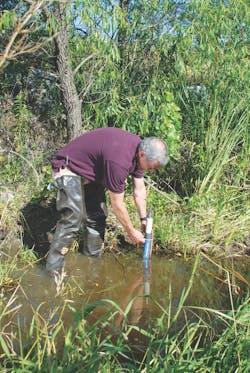Bill Soulliere is environmental product support specialist for Teledyne Isco. Soulliere can be reached at [email protected]. Shoshana Sumrall Frerking is environmental technical writer for Teledyne Isco. Frerking can be reached at [email protected].
undefinedStorm water runoff is a major contributor to surface water pollution, perpetuating ever-increasing state and federal demands for storm water runoff control and reporting. A wide range of flexible instrumentation helps users meet nonpoint source discharge monitoring requirements.
The National Pollutant Discharge Elimination System storm water program regulates storm water discharges from potential sources that include both point and nonpoint sources. Operators and managers of storm sewer systems, construction sites, croplands, industrial sectors and urban areas may be required to obtain authorization to discharge storm water in accordance with federal law and (often more stringent) state and local regulations.
To meet these requirements, businesses, municipalities and other organizations must develop comprehensive storm water monitoring programs. These programs typically consist of several parts, including collecting and storing storm event data on rainfall, flow and measured pollutant levels, as well as taking water samples during the storm event for laboratory analysis. Representative sample collection is dependent on crucial factors such as timing, flow volume and water quality.
Rapidly changing storm conditions can present several challenges to accurate sample collection, monitoring of system status, program adjustment needs and data retrieval. With proper instrumentation, a site-specific system can provide precise automatic sampling with real-time data collection and flexible programming. All of this and more can be achieved from remote locations.
Remote Monitoring & Sampler Commands
The 2105C (CDMA) and 2105G (GSM) cellular interface modules allow a user to remotely enable an Isco Model 6712 portable or Avalanche portable refrigerated wastewater sampler while simultaneously monitoring current site conditions, with flow and water quality data logged and transferred to a secure server database. Immediate access to data and the ability to send commands to a sampler from off site can reduce labor and fuel costs. Additionally, the user can wait until a storm has passed to retrieve the samples, making for safer working conditions.
System Configuration
For active storm water runoff monitoring, the following system components are recommended:
• Model 674 rain gauge;
• 2105C/G cellular interface module;
• 2150 area velocity flow module;
• 6700 Series portable automatic sampler;
• Deep-cycle battery;
• 40-W solar panel;
• Multi-parameter sonde with SDI-12 or Modbus output; and
• Flowlink Pro software.
Basic Operation
The primary functions of the system are to:
• Log real-time water quality and flow data;
• Enable automatic sampling by predetermined conditions;
• Push data to a secure server;
• Remotely enable/pace the sampler; and
• Retrieve sampling reports.
Dialout Alarms
The 2105 can send SMS text alarms to a specified list of phone numbers when a user-defined condition becomes true, such as a rain event, threshold parameter or combination of events.
Supporting Software
Flowlink Pro, a corporate version of Isco’s Flowlink 5.1 flow data management program, supports multiple users. The 2105C/G pushes real-time data to a secure server for hands-off data collection and provides Internet access to the data.
For the customers who already use Flowlink Pro, remote sampler communication and water quality data retrieval can be integrated easily into an established monitoring system.
Sampler
The automatic sampler can be programmed days or weeks ahead of a defined event—for instance, a specific pH level, rainfall accumulation or flow volume—that triggers a primary or secondary sampling protocol via the attached parameter sonde or remotely from the 2105C/G module. Samplers from the 6700 Series can be programmed to take first-flush samples at the start of a storm event. The same sampler then can place subsequent flow-weighted or parameter-based samples in a second group of bottles.
Measurement
Water quality parameters such as pH, dissolved oxygen, conductivity, temperature, turbidity and salinity can be measured by the sonde attached to the sampler controller. This data is transmitted using ASCII protocol from the sampler to the 2105C/G via the serial cable. The 2150 flow module with area velocity sensor measures flow using continuous-wave Doppler technology. The 674 rain gauge uses a tipping bucket design for precision rainfall measurement, and it transmits this data to the 2105C/G. The 2105C/G also is capable of being directly connected to the sonde, with data storage for each parameter configured in Flowlink.
Pushed Data
The 2105C/G module collects the data from all measurement devices in the system. It automatically sends data to a designated server running Flowlink Pro software, using 1xRTT or GPRS packet-switched data transmission at user-specified intervals. A Microsoft SQL, SQL Server Express or Oracle database is required for this function.
Reports & Commands
Remote commands are sent to the sampler via a pass-through function of the 2105C/G and serial cable, using the standard remote commands that are provided in the sampler operation guide. Sampling reports, including input/output status, can be retrieved from the sampler in the same manner.
Aided by a terminal emulator program like HyperTerminal, a user can call the 2105C/G module, then establish RS-232 serial communication with the sampler controller. Once a user has remotely connected to the sampler, it is ready to receive remote commands. Detailed steps for HyperTerminal connection, as well as remote commands, can be found in the Remote Operation section of the sampler operation guide.
System Considerations
Text messaging and pushed data capabilities are available in any location with standard cellular services. Pass-through remote sampler communication via the 2105C/G requires circuit-switched data service.
Download: Here


